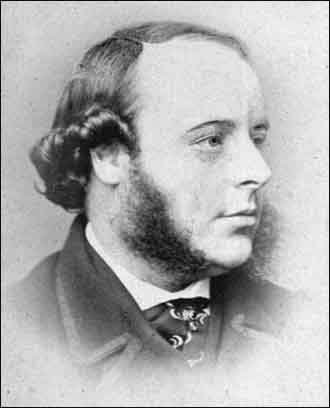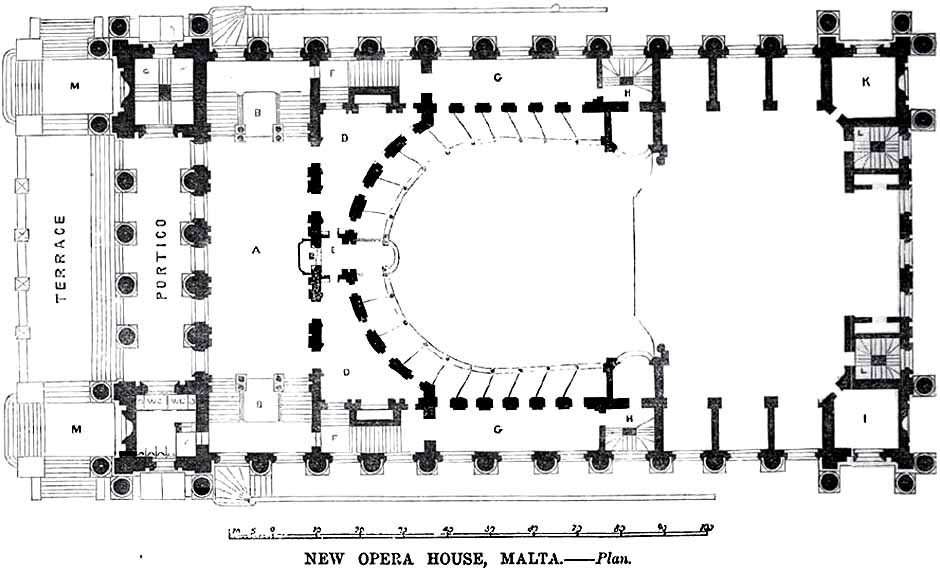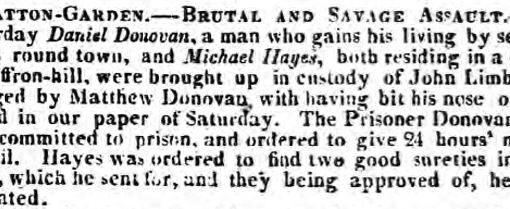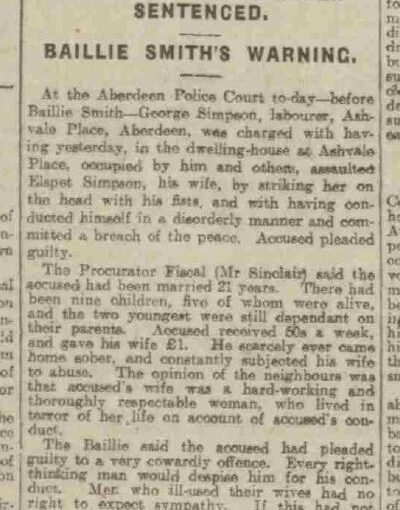 The original Victorian Opera House in Malta’s capital, Valletta was constructed in the 1860′s. These are extracts from The Builder, 2nd May 1863. The New Opera House, Malta was designed by the British architect, Edward Middleton Barry (7 June 1830 – 27 January 1880).
The original Victorian Opera House in Malta’s capital, Valletta was constructed in the 1860′s. These are extracts from The Builder, 2nd May 1863. The New Opera House, Malta was designed by the British architect, Edward Middleton Barry (7 June 1830 – 27 January 1880).
Barry’s portfolio to date up to the mid 1860’s was already quite impressive:
- St Saviour’s Church Hampstead, London (1856)
- Birmingham and Midland Institute (1857, this later became Birmingham Reference Library but was demolished in the 1960s)
- Leeds Grammar School (1857 – now part of the University of Leeds’ Business School)
- Henham Hall, Suffolk; tomb of Alexander Berens in West Norwood cemetery (1858) (photograph in the gallery of West Norwood Cemetery)
- Duxbury Hall, Lancashire (1859)
- St. Giles’s Schools, Endell Street (1860)
- Burnley Grammar School (1860)
- Gawthorpe Hall, Lancashire (additions) (1861)
- Birmingham Free Public Library (1861)
- Pyrgo Park, Romford (additions) (1862)
- Stabling at Millbank for the Speaker (1862)
- Halifax Town Hall, West Yorkshire (designed by Charles Barry, 1860; completed by E.M. Barry, 1863)
- Barbon Park Lodge, Westmorland (1863)
- Royal Opera House, Valletta, Malta (1864)
- the Star and Garter Hotel, Richmond Hill, London (additions) (1865)
- Schools, Canford, Dorset (1865)
- Charing Cross Hotel and the nearby Eleanor cross (a Victorian replica erected in 1863 by the London, Chatham and Dover Railway Company – the original cross was erected by King Edward I in 1291, but removed in 1647), London (1865)
 Edward Barry was the third son of Sir Charles Barry, born in his father’s house, 27 Foley Place, London. In infancy he was delicate, and was placed under the care of a confidential servant at Blackheath. At an early age he was sent to school in that neighbourhood, and then to a private school at Walthamstow, where he remained until he became a student at King’s College London.
Edward Barry was the third son of Sir Charles Barry, born in his father’s house, 27 Foley Place, London. In infancy he was delicate, and was placed under the care of a confidential servant at Blackheath. At an early age he was sent to school in that neighbourhood, and then to a private school at Walthamstow, where he remained until he became a student at King’s College London.
He was apprenticed to Thomas Henry Wyatt for a short time, after which he joined his father’s practice. He continued to assist his father until the latter’s sudden death in 1860, but he had already made considerable progress in working on his own account. In 1848 he had become a student at the Royal Academy, and even while assisting his father found time to devote to works of his own. The first of these was St. Saviour’s Church, Haverstock Hill, in 1855–56. His designs for St. Giles’s schools, Endell Street, which were carried out under his own superintendence in 1859–60, gave him a recognised position. It was to the originality displayed in these works that he owed his admission, in 1861, as an associate to the Royal Academy.
The reconstruction, in 1857, in the short space of eight months, of the theatre at Covent Garden, which had been destroyed by fire, and the erection in the following year of the Floral Hall adjoining, afford examples of his energy, constructive skill, and artistic ability. These works were executed for his own private clients, and without diminishing the assistance which he was then rendering to his father. In 1860 Sir Charles Barry died suddenly, and upon Edward devolved the duty of completing his father’s works. Foremost of these was the new Palace of Westminster, which was at length entrusted to him by the government; and Halifax Town Hall.
On 29 March 1862 he married Lucy, daughter of Thomas Kettlewell. The remaining years of his life record a long series of works designed by him, many of them of national magnitude and importance. In 1869 he was elected an academician, and in 1873, on the retirement of Sir George Gilbert Scott, and then again in 1878 he was elected professorship of architecture in the Royal Academy. In 1874, on the resignation of Sydney Smirke, he was appointed treasurer of the academy.
Among his most significant contributions to London’s architectural scene is the Theatre of the Royal Opera House in Covent Garden. The previous theatre (built by Robert Smirke in 1809) was destroyed in a fire in 1857. Edward Barry was commissioned to design the new “Royal Italian Opera” as it was then known, completing it for its official opening on 15 May 1858. He also designed the adjacent Floral Hall, a stunning glass and cast iron structure, heavily influenced by the Crystal Palace used in the Great Exhibition of 1851. The Covent Garden work was hugely influential in Barry’s appointment to design the Royal Opera House in Valletta, Malta (1866), bombed by the Luftwaffe during the Second World War. Barry often favoured a very classical style (source: Wikipedia).
After Barry’s death the following lecture was published in 1882 marking his significant contribution to achitecture:







